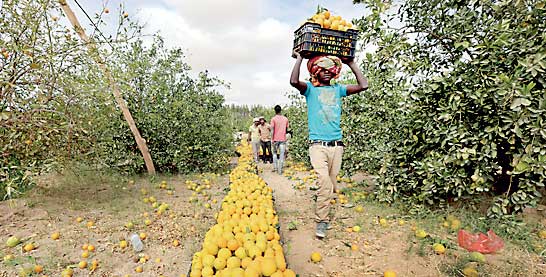Tuesday Nov 26, 2024
Tuesday Nov 26, 2024
Wednesday, 6 January 2016 00:00 - - {{hitsCtrl.values.hits}}
Reuters: Some of the smallest niche agricultural commodities were the biggest winners this year as weather and disease raised concerns about tightening supplies, spurring a buying spree as an exodus of institutional cash punished oil, metals and grains markets.
Cocoa, cotton, sugar and frozen concentrated orange juice on ICE Futures US were on track to be the only gainers this year in the 19-component Thomson Reuters Core Commodity Index.
The index was down by a quarter over the year. This month it hit its lowest level since 2002 as commodities ranging from iron ore to oil took a battering on concerns over excess supply.
Soft commodities were among the few bright spots.
Dry weather in West Africa, where 70% of the world’s cocoa is grown, is expected to hamper the upcoming cocoa crop.
A below-average monsoon is likely to harm sugar and cotton crops in South Asia, while autumn rains in the US Southeast, where farmers had already slashed cotton acreage due to low prices, widely damaged crop quality.
Global orange juice production in the 2014/15 crop year was just 1.7 million tonnes, its lowest level since 1987/88, due to greening that hurts yields.
“Soft commodities, bar coffee, have all been presented with much better fundamentals ... at a time of worries about supply,” said Ole Hansen, head of commodity strategy at Saxo Bank.
“El Nino should keep these commodities supported into 2016, and coffee has the potential of playing catch-up.”
Raw sugar ends the year on a sweet note after rebounding more than 50% off a seven-year low hit in August as analysts expect the market’s first supply deficit in six years to emerge.
In the year when the index sank by a quarter, even a small loss was considered a relatively robust performance.
“You have to have really exceptional fundamental arguments to be able to fight the negative macro tide,” said Michael McDougall, director of commodities at Societe Generale in New York, referring to pressure from the stronger US dollar and slowing growth in China, the top consumer of many raw materials.
To be sure, the so-called soft commodity markets are tiny and some of the most volatile, compared with oil, aluminium and corn.
Open interest in cocoa, cotton, orange juice and sugar combined is around $ 28 billion, or $ 10 billion less than that of aluminium alone and just two-fifths that of Brent crude. Open interest, which refers to the total number of outstanding contracts that have not been settled, can indicate the intensity of trading in a particular market.
On average in 2015, just over 200,000 lots of cocoa, cotton, orange juice and sugar combined traded hands each day, compared with nearly 700,000 lots in Brent crude daily.
Still, speculative interest perked up toward the end of the year. Earlier in December, hedge funds and other speculators had their biggest bullish bets in cocoa in more than a year. In sugar, they built up a record net long position in November.
Other, more heavily traded commodities were harmed by large outflows of capital from the commodities space. Softs did not have as much exposure in the first place.
“Soft commodities are not that well-represented in the big commodity funds, which has also helped cushion them from the continued exodus of institutional investors,” Hansen said.